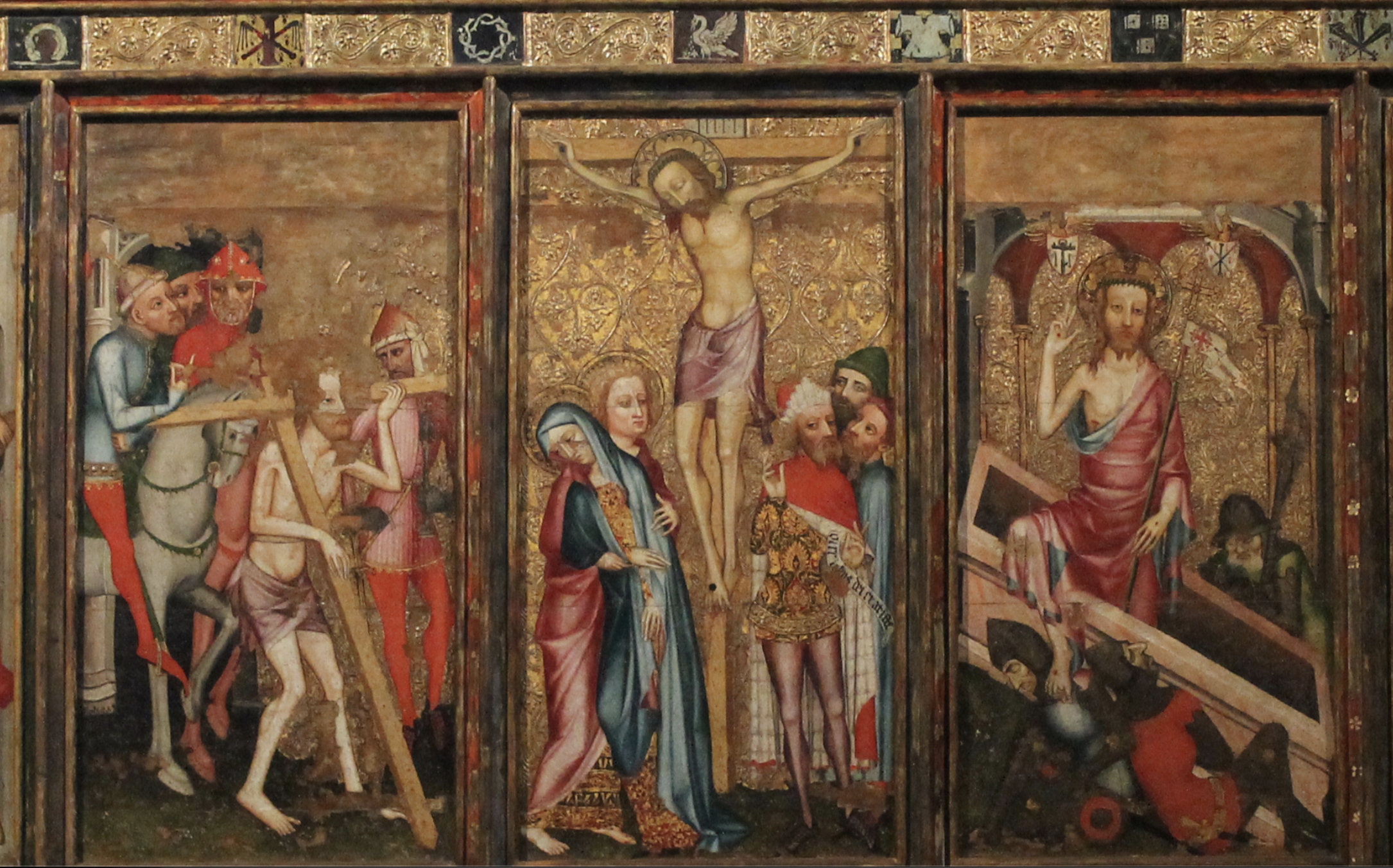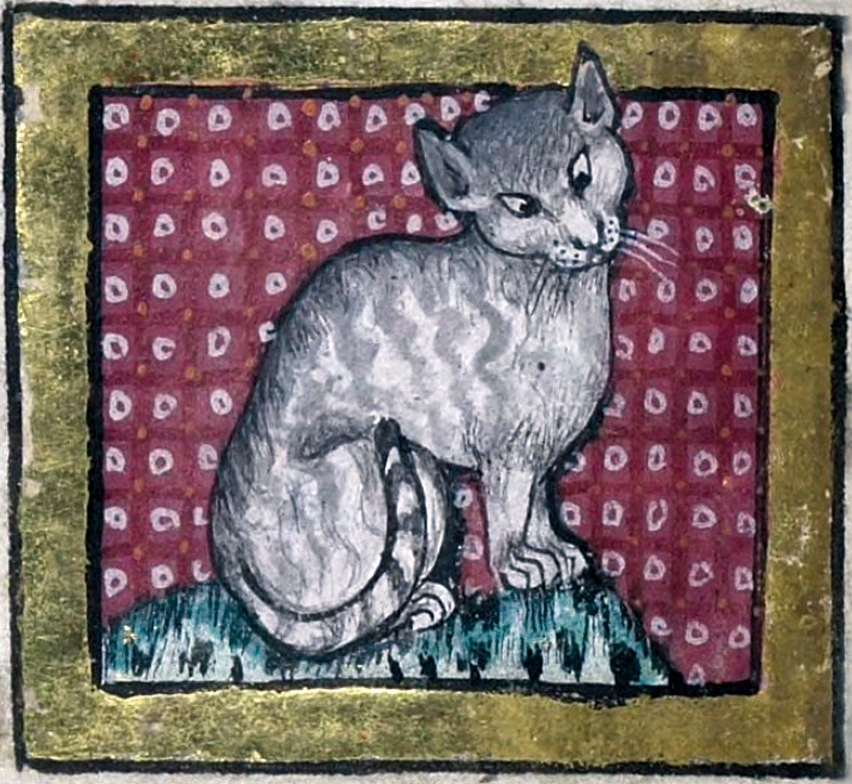“Women in Walls”: Julian of Norwich and the Anchoritic Experience
We’ll begin our exploration of late medieval faith by looking at the writings of Julian of Norwich, one of the most extraordinary visionaries of the late Middle Ages. Julian was inspired to write following a near-death experience she had when she was thirty. You’ll read her account of that experience and then some of the most famous passages of her Showings.
Extracts from the Showings of Julian of Norwich (1373)
Modernized by Abigail S. Greff
Thirty and dying (from Chapter 3)
And when I was thirty and a half years old, God sent me a bodily sickness in which I lay afflicted three days and three nights, and on the fourth night, I received all the rites of Holy Church and thought not to have lived until day; and after this, I languished two more days and two nights. And on the third night, I often thought that I was about to die, and so did they that were with me; and, as I was still young, I thought that it was a great sorrow to die; but not because there was anything on Earth that I desired to live for, nor because I feared any pain, for I trusted God’s mercy. It was rather because if I were to live, then I might love God better and for a longer time, so that I might have more knowledge and love of God in the bliss of Heaven. For I thought that all the time that I had lived here was so little and so short a time, and thus was so little deserving of the reward of endless bliss. Therefore, I thought, “Good Lord, is my living no longer to Your credit?” And I understood through my reason and the feeling of my pain that I should die, and I assented fully with all the will of my heart to be at God’s will. Thus I endured until day, and by then my body felt dead from the middle downwards. Then I desired to be sat upright, leaning while supported with help from underneath, in order to have more freedom of my heart to be at God’s will, and to think about God while my life still lasted.
My curate was sent for to be at my death, and by the time he had come, my eyes were set in a stare and I might not speak. He set the Cross before my face and said, “I have brought you the image of your maker and Savior. Look upon it and comfort yourself with it.” It seemed to me that I was well-situated for my eyes were set straight upward to Heaven where I trusted to come by the mercy of God, but nevertheless, I assented to set my eyes on the face of the Crucifix, if I might; and so I did. For I felt that it might be easier to look straight ahead than straight up. After this, my sight began to fail and it was all dark around me in the chamber as if it were night, except for the image of the Cross, bathed in light, I knew not how. All that was around the Cross was ugly to me, as if it was all full of fiends. After this, the rest of my body began to die so that to a great extent I had scarcely any feeling, with shortness of breath; and then I truly thought to have died.
And in the middle of this, suddenly, all my pain was taken from me, and I was as healthy … as I ever was before.
Creation as a hazelnut (from Chapter 5
How God is to us everything that is good, tenderly enveloping us; and all things that are made, in regard to the Almighty, are nothing; and how man has no rest until he renounces himself and all things for the love of God. The fifth chapter.
In this same time our Lord showed to me a ghostly sight of His homely loving. I saw that He is everything to us that is good and comfortable for us. He is our clothing, that for love winds around us, embraces us, and surrounds us for tender love, so that He might never leave us, being to us everything that is good as to my understanding. Also, He showed a little thing the size of a hazelnut in the palm of my hand, and it was as round as a ball. I looked upon it with my eye of understanding and thought, what might this be? And the answer was this: It is all that is made. I marveled at how it might last, for it seemed to me that it would take little to make it suddenly fall to nothing. And I was answered in my understanding, It lasts and ever shall, for God loves it; and so all things have being by the love of God.
In this little thing I saw three properties: the first is that God made it, the second is that God loves it, and the third, that God keeps it. But who is truthfully my maker, keeper, and lover I cannot tell, for until I am substantially united with Him, I may never have complete rest nor true bliss; that is to say, when I am so joined to Him, that there is nothing between my God and me. We need to have knowledge of the littleness of creatures and renounce everything that is made so that we might love and have God, who is without a maker. For this is the reason that we are not all at ease in heart and soul: we seek rest here in those things that are so little, wherein there is no rest, and do not know our God, who is all mighty, all wise, all good; for He is the true rest. God will be known, and it pleases Him that we rest in Him. For all that is beneath Him does not satisfy us. And this is why no soul has rest until it has renounced all things that are made. When it has willfully renounced all for love, to have Him that is all, then it is able to receive ghostly rest.

Blood like rain drops, like herring scales (from Chapter 7)
[W]ith ghostly sight I saw the bodily sight of the plenteous bleeding of the head. The great drops of blood fell down from under the crown like pellets, seeming as if they had come out of the veins, and in coming out they were brownish red, for the blood was extremely thick, and as they spread the drops were bright red, and when they had come to the brows, then they vanished; notwithstanding, the bleeding continued until many things were seen and understood.
The fairness and the liveliness are like nothing else but themselves. The plenteousness of the blood is like the drops of water that fall from the eaves after a great shower of rain that falls so thick that no man may count them with bodily wit; and as for the roundness, it was like the scale of a herring as it spread on the forehead. These three came to my mind at the time: pellets, for the roundness of the blood as it was coming out; the scale of a herring, for roundness, as it spread over the forehead; the drops from the eaves, for the innumerable plenteousness. This showing was quick and lively and hideous and dreadful, sweet and lovely.
“All shall be well” (from Chapter 27)
Jesus, who in this vision informed me of all that I needed, said: Sin is fitting (behovabil), but all shall be well, and all shall be well, and all manner of things shall be well.
Mastery Check:
- How does Julian’s vision of the cross resemble and differ from that of the Dreamer in the Old English “Dream of the Rood”?
- Julian likens the drops of Christ’s blood to what?
- To what does Julian compare creation?
- What range of approaches did medieval artist and authors take to the Crucifixion?
- In what way is Isaac like Christ?
Julian: Woman in a Wall
We know very little about Julian of Norwich, except that she eventually lived an anchoress—whether she pursued that vocation before or after her near-death experience is anyone’s guess. Anchoritism is a way of life we in the twenty-first century have a hard time wrapping our minds around: a person decides to dedicate themselves to God by living their lives enclosed in a cell that was typically the size of, say, a bedroom. That cell often adjoined a church to allow the anchorite to participate in religious services. As part of an anchorite’s enclosure ceremony, the bishop would recite the office of the dead to signify that the anchorite was dead to the world. The anchoritic vocation particularly appealed to medieval women, anchoresses, “women in walls,” as my colleague Nicholas Hoffman aptly calls them.
Perhaps inspired by medieval anchoritism, Gothic novelists imagined characters (usually women) being bricked into a wall and left to die, sometimes as a punishment for forbidden love.
The medieval anchoritic experience was something wholly different. Watch the following video lecture to learn why medieval people—especially women—were drawn to this strange vocation.
The Anchorhold: Without and Within
Things anchoresses weren’t and were supposed to do
Because the activities of anchoresses were not governed by a formal rule, clergymen often wrote guides to help them structure their lives. These guides are full of instructions about what anchoresses should not do, which gives you a sense of some of the things at least some anchoresses did do:
- Dine out
- Gossip
- Touch visitors
- Keep other people’s property (i.e., use the anchorhold like a modern safety deposit box)
- Teach children
- Conduct business
- Dispense charity
- Own any animal–except a cat
Guides for anchoresses were also remarkably humane. Whereas some thought that being holy required extreme fasting and other forms of self harm, anchoritic guides urged devotion rooted in self care:
- Read, eagerly and long
- Meditate and pray
- Wear comfortable shoes
- Dress cooly in the summer and warmly in the winter
- Get enough sleep


Mastery Check:
- What do medieval guides for anchoresses reveal about life in a medieval anchorhold?
- What were anchoresses encouraged (not) to do
- How did medieval anchorites and anchoresses relate to their communities?
- Which animal was more appropriate for an anchoress–a cow or a cat–and why?
- How did a person become an anchoress?
- Who financed the anchorite’s lifestyle?
The isolation you experienced during the COVID-19 lockdown gives you a unique insight into the lifestyle of a medieval anchorite, separated from the world but still a part of it and able to maintain meaningful relationships with others despite physical distance.
Among the many visitors to Julian’s cell in Norwich was a wife, mother of fourteen, entrepreneur, pilgrim, visionary, and future author named Margery Kempe. You’ll read Kempe’s account of their meeting in the next section, which introduces you to a woman who could not be more unlike Julian.
An anchoress (or anchorite) is someone who, for religious reasons, withdraws from secular society so as to be able to lead an intensely prayer-oriented, ascetic, or Eucharist-focused life. Whilst anchorites are frequently considered to be a type of religious hermit,[2] unlike hermits they were required to take a vow of stability of place, opting for permanent enclosure in cells often attached to churches. Also unlike hermits, anchorites were subject to a religious rite of consecration that closely resembled the funeral rite, following which they would be considered dead to the world, a type of living saint. Anchorites had a certain autonomy, as they did not answer to any ecclesiastical authority other than the bishop. (source: Wikipedia)
Margery Kempe (c. 1373 – after 1438) was an English Christian mystic, known for writing through dictation The Book of Margery Kempe, a work considered by some to be the first autobiography in the English language. Her book chronicles her domestic tribulations, her extensive pilgrimages to holy sites in Europe and the Holy Land, as well as her mystical conversations with God. (source: Wikipedia)